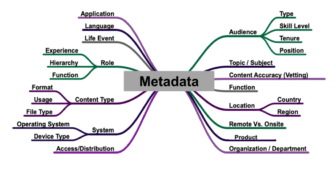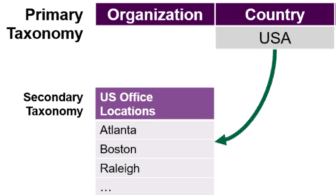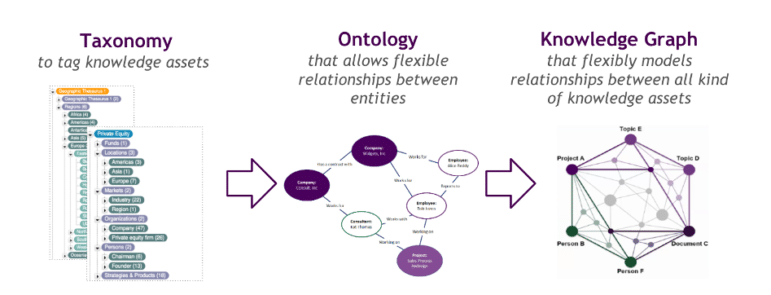The necessity of a business taxonomy has become increasingly apparent as organizations across the globe have shifted to working from home and, consequently, have an increased need for their employees to be able to quickly and independently find and discover information. While organizations from a wide range of industries have recognized the value of designing and implementing a business taxonomy, all too often, we see organizations’ taxonomy ambitions squashed due to a lack of adherence to or understanding of taxonomy design best practices.
In this two-part blog series, I’ll share some common mistakes we see when it comes to taxonomy design and offer guidance around how to ensure your organization’s business taxonomy can avoid these pitfalls and be best positioned for success. More specifically, this first installment will share some of the most common taxonomy design mistakes that stem from organizations failing to design their taxonomy with a user-centric approach, with part two focusing on identifying and involving the most critical systems and users throughout the design process. By starting your taxonomy design efforts on the right track, you can ensure that your taxonomy design meets the wants and needs of your end-users, gains adoption, and is immediately intuitive to those who engage with it.
What is a Business Taxonomy?

At Enterprise Knowledge, we define a business taxonomy as a controlled vocabulary that is used to describe or characterize explicit concepts for the purpose of capturing, managing, and presenting information. In other words, taxonomy design can be thought of as a way to categorize your organization’s current and future content items in a consistent and intuitive way so that employees, stakeholders, and/or customers can quickly and easily  store, manage, and retrieve the information that they need. Designing an effective taxonomy is all about collecting the information that is already available, then organizing it to help your end users find and use the correct information efficiently and effectively. The end product—a taxonomy— is a standardized list of terms that can be applied to product categorization, web site structure, and faceted navigation.
store, manage, and retrieve the information that they need. Designing an effective taxonomy is all about collecting the information that is already available, then organizing it to help your end users find and use the correct information efficiently and effectively. The end product—a taxonomy— is a standardized list of terms that can be applied to product categorization, web site structure, and faceted navigation.

Mistake #1: Purchasing an Off-the-Shelf Taxonomy
One of the primary reasons we have seen taxonomy designs not provide their optimal value to an organization is because that organization has opted to purchase an “Off-the-Shelf” taxonomy design rather than develop a taxonomy exclusively for their unique end users. An “Off-the-Shelf Taxonomy” is marketed as a “one size fits all” taxonomy that is designed and sold by a vendor for a particular industry, domain, or type of organization. For example, an automobile manufacturing organization may purchase an off-the-shelf taxonomy designed for organizations within the manufacturing industry, thinking “If this taxonomy is based around industry language, it must work for my organization.”
The primary problem with an off-the-shelf taxonomy design is that it relies on generic industry terms or means of categorizing information rather than the content, language, and knowledge that is leveraged every day to make your unique organization successful. Ultimately, an off-the-shelf taxonomy design, because it is likely too broad or unnecessarily detailed for your organization, will cause your end users to suffer from an inability to find or discover the information that they need to do their job, make a purchase, or complete a task. In some cases, your end users might not even recognize terms in the taxonomy at all, leading to confusion and/or abandonment of the system or site in which the taxonomy is leveraged. This can lead to the following impacts on taxonomy end user groups:


Mistake #2: Designing a “Do It Yourself” Taxonomy or Not Using a Third Party
Many of our clients partner with us at Enterprise Knowledge to tackle their taxonomy design after they have worked to design a taxonomy using internal resources. Oftentimes, this previously designed taxonomy did not provide adequate value to the organization because an individual or small group within the organization acted as the primary designer(s). By designing a taxonomy largely in isolation, with only the input and purview of a small group being taken into account, it is more likely that the taxonomy design will not work for a more diverse end user group and contains unintentional biases or motives held by those employees. For example, we worked with a client whose cross-departmental taxonomy was developed solely by two members of the IT department. While the entirety of the organization’s IT department found the taxonomy to be extremely valuable in facilitating the tagging and findability of the content items that they needed, other departments who were utilizing the taxonomy found it to be too granular for certain types of content and too generic or confusing for others. This led to a taxonomy design that only worked well for one of the multiple departments that relied on it to find the content they needed to do their jobs.
Similarly, while taxonomy research and literature is abundant, having an expert taxonomist be involved in or lead your organization’s taxonomy design efforts will enable you to yield better results post-implementation, as you will guarantee that their experience and knowledge will be brought to bear during the development phase. In our experience, while some organizations are able to accurately capture the language of their users, many lack dedicated taxonomy experience, leading to a taxonomy design that does not adhere to best practices, is not structured in a way that lends to machine readability, or cannot be properly implemented into the intended system or repository. In some cases, it is best for the taxonomy expert to be an individual outside of your organization, as they can be completely removed from company biases or relationships and serve as a mediator and primary decision-maker when necessary.

Mistake #3: Avoiding a Taxonomy Design Altogether
With artificial intelligence and semantic technologies becoming increasingly popular across a host of industries, many of our clients come to EK to determine the right place to start for their organization. All too often, however, organizations want to start at the cutting-edge and neglect the foundational role that a business taxonomy plays in enabling these technologies, and their business, to be successful.
Arguably, the biggest taxonomy design mistake that an organization can make is to not design a taxonomy at all, particularly if that organization is seeking to increase its maturity in knowledge management and semantic technologies. A business taxonomy not only drives the classification and findability of information, information architecture, and search filtering/faceting, but paves the way for artificial intelligence and semantic technologies by creating standardization and alignment across an organization. As outlined in the EK blogs “From Taxonomy to Ontology,” and “Natural Language Processing and Taxonomy Design”, taxonomies serve as the building blocks for ontologies, knowledge graphs, and other semantic technologies by identifying basic similarities and hierarchical relationships between concepts and content within the organization that can be leveraged to develop more complex, flexible relationships between entities and knowledge assets. By developing a successful business taxonomy, you can ensure that your organization’s semantic technology efforts align with the actual content or domain you are working in and accurately model your organization’s knowledge and information.


Avoiding Common Pitfalls Through a User-Centric Taxonomy
The best way to avoid the common taxonomy mistakes described above is to design a user-centric taxonomy, in which representatives from primary end users groups are involved in the process from the very beginning. By engaging end users in workshops, interviews, focus groups, system demos, and validation activities, you can ensure that your organization’s business taxonomy design is usable, intuitive, and valuable to a majority of user groups. Further, by identifying and involving the most critical end users and system considerations into your taxonomy design, as I will discuss in part II of this blog series, you can ensure that your business taxonomy is designed with the right needs, motivations, and system capabilities in mind. Using our proven Business Taxonomy Design Methodology, EK can help you design and implement a business taxonomy that works for your organization and its goals.
Interested in learning more? Contact us at info@enterprise-knowledge.com to speak with our team of taxonomy experts.
